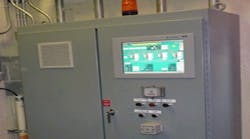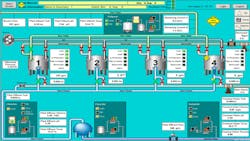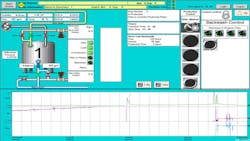Mention Alaska and you might picture pristine natural vistas surrounded by clear, cold waters. While this picture is accurate, the near freezing waters off Alaska’s Southern coast and the frigid climate is a daily challenge to many area plant operations – including a local water treatment plant that provides water to a branch of the U.S. armed services stationed there.
To serve its community of more than 4,000 people, the plant processes more than 350,000 gallons of water on average per day, drawing from a nearby lake and river. Every day, natural forces present a new challenge – from volcanic ash to decaying fish residue. The Alaskan climate also means that plant operators must work diligently to keep water flowing throughout the treatment process to prevent pipes from freezing.
The plant needed to increase filtration capacity to support the needs of the military base and improve reporting capabilities to comply with both regulatory requirements and base sustainability goals. The existing 1970s-era control system was a maintenance headache at current capacity and offered limited reporting and data-storage capabilities.
Plant management knew they needed to upgrade their control system to improve capacity, diagnostics and efficiency. They turned to Dowland-Bach, an authorized Rockwell Automation Recognized System Integrator, for help with modernizing their control system.
Water treatment in Alaska carries some unique challenges, including higher risk of frozen pipes and higher than average water turbidity – the amount of suspended solids in the water.
The plant uses a pressure filter system to remove solids from raw water. Historically, plant operators have to disable the filtration system to analyze the source of turbidity when acceptable levels are exceeded. This could be anything from the remnants of decaying fish following an especially large salmon run to a landslide of 100-year-old volcanic ash in to the feeder lake. Operators would manually adjust chemical additives to address the source of the turbidity. By implementing automatic coagulant additive controls with feedback from streaming current detectors, shutdowns in such circumstances are eliminated.
Access to real-time data is invaluable for process optimization and troubleshooting at the water treatment plant— Steve Parkinson, automation and controls engineer at Dowland-Bach.
Additionally, the Southern-coast plant has to keep water flowing constantly to prevent ice from building up. To create a continuous water flow, water is often dumped into the ocean, wasting the treated water. If the water does freeze, whole sections of the water delivery system are taken offline until the blockage can be unfrozen.
The plant could consume fewer resources and improve its efficiency with better visibility into and control over water levels, temperature and flow rates. The plant also needed more efficient, plant wide reporting on water temperatures, levels and turbidity in its five reservoirs.
Generating reports for the Alaska Department of Environmental Conservation (DEC) had been a frustrating process because operators had to scroll through each day’s one-minute samples to locate high-turbidity points. The manual process left room for inaccuracies and inconsistent reporting, and the SQL-based system frequently shut down when it reached capacity, archiving only a portion of the process data, plus forcing an operator to clear out old data to make room for the new.
What’s more, the water treatment plant was unmanned for part of each day and alarm conditions were reported to the base’s steam-generation plant operators, located several miles away. Steam plant operators were notified of an alarm during off-hours, but they had no way of seeing the source of the alarm. So, a water plant operator had to physically go over to the water treatment plant to perform a site check to determine the cause of the alarm.
As a whole, the plant needed to increase filtration capacity, and improve reporting and maintenance efficiency.
To modernize the control system, Dowland-Bach installed an Allen-Bradley® CompactLogix™ programmable automation controller (PAC), upgraded the pressure filter, capacity, metering, wiring, and control systems. The new system also improved visibility at the water treatment and steam plants.
The CompactLogix PAC integrates safety, motion and drive capabilities on a single platform while continuously collecting critical operating data.
The FactoryTalk® software suite built out the plant’s visualization and reporting capabilities. FactoryTalk® View Site Edition (SE) software provides a window into the entire plant from stand-alone human-machine interface (HMI) systems or via a thin client Web browser, so operators can view real-time data from both the water treatment and steam plants.
Dowland-Bach also installed FactoryTalk® Historian Site Edition (SE) software, to collect and analyze up to 25 years of plant data. Operators can now view real-time and historical data as trends, allowing operators to quickly identify sources of turbidity or leaks. To ease the burden of regulatory reporting, FactoryTalk Historian is also used to transcribe data from the historian into a format that can be shared with the Alaska DEC.
“Access to real-time data is invaluable for process optimization and troubleshooting at the water treatment plant,” explained Steve Parkinson, automation and controls engineer at Dowland-Bach. “Knowing where the problem is, and when and why it occurred allows operators to fix it before it becomes a major concern or costly repair.”
Before installing their new system, it took operators six hours to generate one report for the Alaska DEC – a task that had to be repeated five times per month, at an annual cost of $18,000. Now, the plant can produce a report in minutes. “Using the FactoryTalk software to pull data eases operators’ daily decisions and helps them to see trends more quickly and more accurately,” said Parkinson.
The plant is required to keep seven years of data on their system, which overworked their original system and caused it to break down when it reached capacity. This typically happened once each quarter and cost the plant $20,000 annually in maintenance costs alone. With FactoryTalk software, the plant can easily store 25 years of data and has eliminated unplanned maintenance and downtime due to reporting.
The plant is now achieving a high level of reporting accuracy, easily producing 24-hour trend reports on water temperatures and levels for each reservoir. At a glance, operators can now see exactly how much water has been used over the past 24 hours, and can detect and locate abnormal conditions quickly and make necessary adjustments. This has reduced the amount of treated water the plant has to dump to keep water flowing and has allowed operators to detect and address turbidity increases before they exceed maximum requirements.
Steam plant operators also have better visibility into the alarm system. For example, if an alarm shows a leak in a water main, they can now track the exact location and timing of it. This helps determine if the issue needs to be addressed immediately or if it can wait for the on-site water treatment staff to return.
“With an updated automation system, we helped improve reporting capabilities at the water treatment plant, which helps protect water quality,” said Parkinson. “Today the plant is operating more efficiently with improved diagnostic capabilities – all while using fewer resources.”
The results mentioned above are specific to Dowland-Bach’s use of Rockwell Automation products and services in conjunction with other products. Specific results may vary for other customers.





